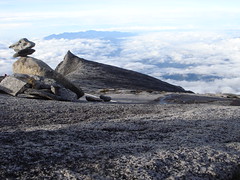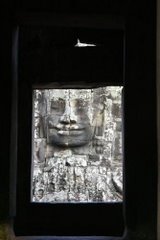 Start the day with a walk inside the market with the dominant dome, Psar Thmei. As I am a big breakfast-supporter which literally means that I will die without breakfast, the first mission will be to scout for a place to eat and the ambience of the food market in the pic above is pretty similar to the ordinary market we have back in Sandakan, only more jam-packed. (Oh, this brings me to the sentiment of the Old Market back in Sandakan, which had been torn down to give way to a new road in town and a financially-controversial-new and sanitized version was built but that's another story)
Start the day with a walk inside the market with the dominant dome, Psar Thmei. As I am a big breakfast-supporter which literally means that I will die without breakfast, the first mission will be to scout for a place to eat and the ambience of the food market in the pic above is pretty similar to the ordinary market we have back in Sandakan, only more jam-packed. (Oh, this brings me to the sentiment of the Old Market back in Sandakan, which had been torn down to give way to a new road in town and a financially-controversial-new and sanitized version was built but that's another story) The rule of thumb of selection food in foreign unknown places : Go for the stalls where lots of ppl waiting and queing. The stall owner managed to crack some broken English, i.e. Thank You and OK though I wish I can speak some Khmer with her.
The rule of thumb of selection food in foreign unknown places : Go for the stalls where lots of ppl waiting and queing. The stall owner managed to crack some broken English, i.e. Thank You and OK though I wish I can speak some Khmer with her. Stalls selling fresh produce.
Stalls selling fresh produce. Another section fo the market, with cobblers and tailors stalls lining up to serve you.
Another section fo the market, with cobblers and tailors stalls lining up to serve you.Reached there via a tuk-tuk along some dusty-nasty road so, prepare a surgical mask or small hankie or towel if you have respiratory related allergy or sickness. Contrary to its appearance which resembles the Thai palace architecture, this marble-white building with golden colored roof houses all the skulls of the victims who had been killed mercilessly in the Killing Field of Choeung Ek. It's an episode of unbelievably sad chapter of Cambodian history where approximately 17,000 men, women, children and infants were transported to this extermination camp after being detained and tortured in S-21 (or better known as Tuol Sleng Museum now, used to be Tuol Svay Prey High School - the Khmer word Prey may mean something else but the place it turned into during Pol Pot's time really befits the meaning of the word in English)between 1975 and 1978.
 This is the tree where a loud speaker was held and blaring out maximum volume of music when the extermination was carried out to mask the horrid sound of screams of the victims.
This is the tree where a loud speaker was held and blaring out maximum volume of music when the extermination was carried out to mask the horrid sound of screams of the victims.
 God bless the souls of the victims. No offense. I posted this out of respect, hoping that ppl realize the trauma of the Cambodian caused by Pol Pot.
God bless the souls of the victims. No offense. I posted this out of respect, hoping that ppl realize the trauma of the Cambodian caused by Pol Pot.
 The classrooms which were turned into the torturing rooms during the Pol Pot time.
The classrooms which were turned into the torturing rooms during the Pol Pot time.
 The torturing bed. God know what happened in that 3 years from 1975 to 1978.
The torturing bed. God know what happened in that 3 years from 1975 to 1978.
 Guillotine-like structure where they hang the prisoners and immersed them into basins of human excretes for interrogation.
Guillotine-like structure where they hang the prisoners and immersed them into basins of human excretes for interrogation.
 The number represents the number of cell-like division in the classrooms housing the prisoners for interrogation.
The number represents the number of cell-like division in the classrooms housing the prisoners for interrogation.
 This poster really captured my attention as it really did convey the message. The map of Cambodia made up of skulls.
This poster really captured my attention as it really did convey the message. The map of Cambodia made up of skulls.
 This is the tree where a loud speaker was held and blaring out maximum volume of music when the extermination was carried out to mask the horrid sound of screams of the victims.
This is the tree where a loud speaker was held and blaring out maximum volume of music when the extermination was carried out to mask the horrid sound of screams of the victims. God bless the souls of the victims. No offense. I posted this out of respect, hoping that ppl realize the trauma of the Cambodian caused by Pol Pot.
God bless the souls of the victims. No offense. I posted this out of respect, hoping that ppl realize the trauma of the Cambodian caused by Pol Pot.Not for the faint-hearted visitors as this is a testament of the cruelty and monster-like actions of human kind comparable to Hitler's doing. The site is actually quite suburb-feel and less dramatic save for some obvious structure used for torturing. The school is ordinary, with plenty of classrooms now with displays of black and white photographs of all the men, women and children detained. The Khmers made a questionable effort to meticulously document all the details of the detainee including their names, origins, background etc which later become essential in setting up the whole museum. The whole experience is horrifying in a very calm manner. It's like watching a horror movie without all the cliche plot and predictable musics. It's silent but not quiet. The pics were harrowing because all the ppl in the pic were spotting some despair, desperate and hopeless expressions. I found the pictures were more emotionally-haunting than the sight of the torturing device on display.
Again, it's NOT a place for those who's squeamish.
 The classrooms which were turned into the torturing rooms during the Pol Pot time.
The classrooms which were turned into the torturing rooms during the Pol Pot time. The torturing bed. God know what happened in that 3 years from 1975 to 1978.
The torturing bed. God know what happened in that 3 years from 1975 to 1978. Guillotine-like structure where they hang the prisoners and immersed them into basins of human excretes for interrogation.
Guillotine-like structure where they hang the prisoners and immersed them into basins of human excretes for interrogation. The number represents the number of cell-like division in the classrooms housing the prisoners for interrogation.
The number represents the number of cell-like division in the classrooms housing the prisoners for interrogation. This poster really captured my attention as it really did convey the message. The map of Cambodia made up of skulls.
This poster really captured my attention as it really did convey the message. The map of Cambodia made up of skulls.SIDE NOTE :
During my visit to the Tuol Sleng Museum, I was listening to the guide explaining the whole gruesome chapter of the darkest episode of Cambodian history and I couldn't help but noticing the guide was speaking with sadness and anger. But who wasn't? From what I learned from the locals, it's the unspoken taboo or incident which still provokes some haunting memories of any Cambodian till this day. Almost every family had one or more of its member who was killed during the Khmer Rouge time.






1 comment:
Joe, your technique improved alot... i like the "USD20 Mekong Trail" story very much...the "askar" with M16...hahahaha
Post a Comment